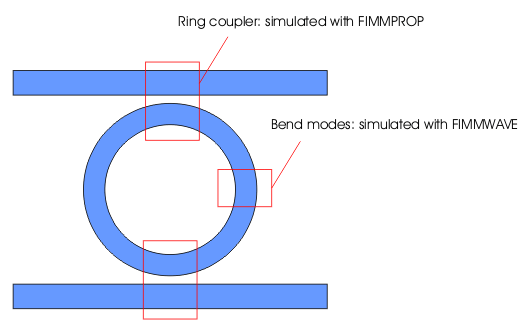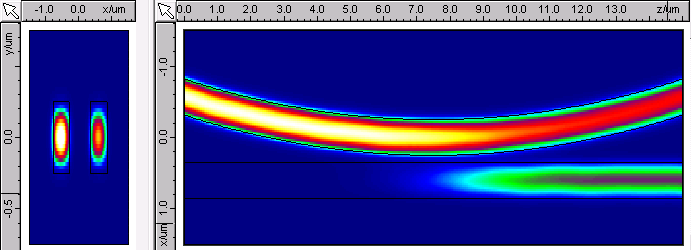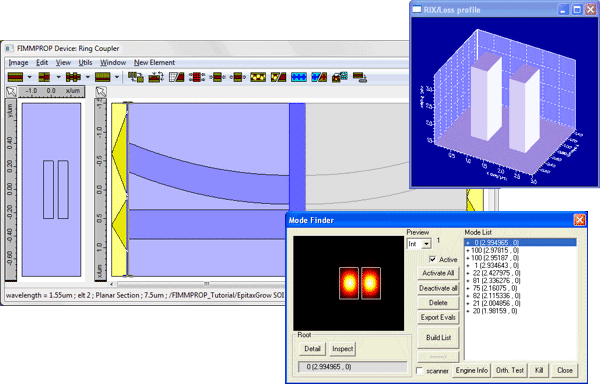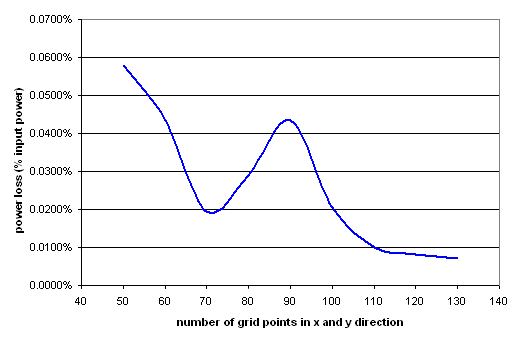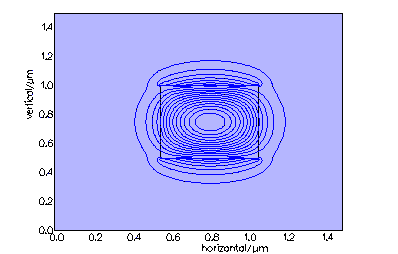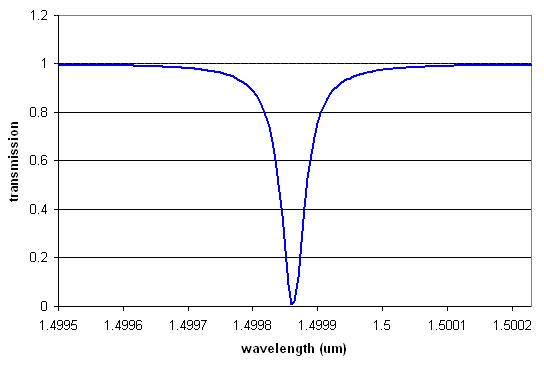FIMMPROPA bi-directional optical propagation tool |
   |
Optical Ring Resonator3D simulation with FIMMWAVE and FIMMPROP softwareAn optical ring resonator made in silicon on insulator waveguides (SOI) was entirely simulated with the Photon Design mode solver FIMMWAVE and its 3D propagation tool FIMMPROP. FIMMPROP was used to model the coupling region and the FIMMWAVE bend solvers were used to calculate the properties of the bend modes in the ring. The spectral response of the device was then calculated analytically. Simulation of the
optical ring coupler
1. Simulation of the optical ring couplerFIMMPROP, our optical propagation tool based on Eigenmode Expansion (EME), can simulate the coupling regions of ring resonator filters very efficiently and with very good accuracy thanks to its taper algorithm, even for large ring diameters that cannot be solved with the FDTD method. EME allows to solve the structure in terms of local modes, which is a very efficient way to simulate optical coupling.
FIMMPROP is a very efficient method for modelling such structures:
DesignDesign parameters:
The design of a ring resonator in FIMMPROP can be performed easily with dedicated pre-defined components. The different parts of the device can be set to materials, allowing FIMMPROP to take dispersion effects into account when working at different wavelengths.
SimulationSimulation parameters:
Coupling coefficients FIMMPROP calculated the scattering matrix of the structure using its taper algorithm. An
estimated accuracy of 0.01% was obtained
to calculate the coupling coefficient for the TE-like mode. The results are given below.
Mode coupling analysis FIMMPROP can plot the evolution of the effective indices of the local modes along the device, as shown below for the first four modes of the structures. At the beginning of the device, when the ring is far from the straight waveguide, the modes are decoupled. The modes of the straight section have constant effective indices, as can be seen below (green and bright blue lines). When the waveguides get closer, the modes become coupled. The variations between z = 5um and 15um illustrate the effect of the coupling region on the effective indices.
Calculation of uncertainty and accuracy optimisation FIMMPROP allows you to calculate how much power is lost from the simulation along the device, allowing to estimate the uncertainty on the results and to optimise the resolution needed to obtain convergent results.
2. Calculation of the bend modes in the ringThe bend modes in the ring were calculated using the FDM Solver in FIMMWAVE. The FDM Bend Solver allows you to calculate bend modes. In this case the bend modes had already been calculated in order to launch the correct bend mode in the FIMMPROP ring coupler simulation.
Thanks to the high confinement and the large radius, the losses in the ring were found to be negligible.
3. Calculation of the transmission spectrumUsing the results provided by FIMMWAVE and FIMMPROP, the transmission spectrum of the ring coupler was calculated analytically using:
where t is the transmission coefficient of the coupling region in amplitude, R is the radius of the ring, neff is the effective index, Ng is the group index, Φ is the phase shift in the loop and λ is the wavelength. The reference values were taken at 1.5um. The results are plotted below:
You can very easily obtain a high resolution spectrum around a resonance peak:
4. Further simulations: full ring and multiple ring modellingFIMMPROP can also be used in conjunction with PICWave to calculate highly accurate transmission spectra for advanced geometries of ring resonators including multiple rings. 5. ReferencesExamples of ring resonator modelling using FIMMPROP have been presented at the ECIO 2010 conference in Cambridge, UK.
|

